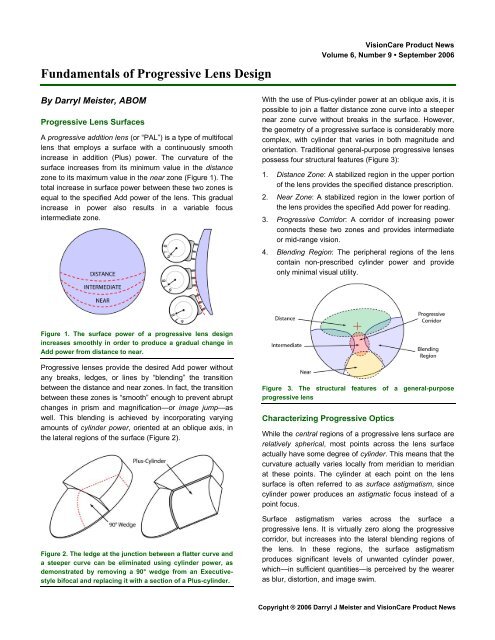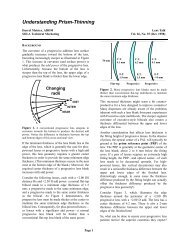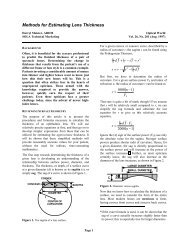Fundamentals of Progressive Lens Design - Laramy-K Optical
Fundamentals of Progressive Lens Design - Laramy-K Optical
Fundamentals of Progressive Lens Design - Laramy-K Optical
You also want an ePaper? Increase the reach of your titles
YUMPU automatically turns print PDFs into web optimized ePapers that Google loves.
<strong>Fundamentals</strong> <strong>of</strong> <strong>Progressive</strong> <strong>Lens</strong> <strong>Design</strong><br />
VisionCare Product News<br />
Volume 6, Number 9 • September 2006<br />
By Darryl Meister, ABOM<br />
<strong>Progressive</strong> <strong>Lens</strong> Surfaces<br />
A progressive addition lens (or “PAL”) is a type <strong>of</strong> multifocal<br />
lens that employs a surface with a continuously smooth<br />
increase in addition (Plus) power. The curvature <strong>of</strong> the<br />
surface increases from its minimum value in the distance<br />
zone to its maximum value in the near zone (Figure 1). The<br />
total increase in surface power between these two zones is<br />
equal to the specified Add power <strong>of</strong> the lens. This gradual<br />
increase in power also results in a variable focus<br />
intermediate zone.<br />
With the use <strong>of</strong> Plus-cylinder power at an oblique axis, it is<br />
possible to join a flatter distance zone curve into a steeper<br />
near zone curve without breaks in the surface. However,<br />
the geometry <strong>of</strong> a progressive surface is considerably more<br />
complex, with cylinder that varies in both magnitude and<br />
orientation. Traditional general-purpose progressive lenses<br />
possess four structural features (Figure 3):<br />
1. Distance Zone: A stabilized region in the upper portion<br />
<strong>of</strong> the lens provides the specified distance prescription.<br />
2. Near Zone: A stabilized region in the lower portion <strong>of</strong><br />
the lens provides the specified Add power for reading.<br />
3. <strong>Progressive</strong> Corridor: A corridor <strong>of</strong> increasing power<br />
connects these two zones and provides intermediate<br />
or mid-range vision.<br />
4. Blending Region: The peripheral regions <strong>of</strong> the lens<br />
contain non-prescribed cylinder power and provide<br />
only minimal visual utility.<br />
Figure 1. The surface power <strong>of</strong> a progressive lens design<br />
increases smoothly in order to produce a gradual change in<br />
Add power from distance to near.<br />
<strong>Progressive</strong> lenses provide the desired Add power without<br />
any breaks, ledges, or lines by “blending” the transition<br />
between the distance and near zones. In fact, the transition<br />
between these zones is “smooth” enough to prevent abrupt<br />
changes in prism and magnification—or image jump—as<br />
well. This blending is achieved by incorporating varying<br />
amounts <strong>of</strong> cylinder power, oriented at an oblique axis, in<br />
the lateral regions <strong>of</strong> the surface (Figure 2).<br />
Figure 2. The ledge at the junction between a flatter curve and<br />
a steeper curve can be eliminated using cylinder power, as<br />
demonstrated by removing a 90° wedge from an Executivestyle<br />
bifocal and replacing it with a section <strong>of</strong> a Plus-cylinder.<br />
Figure 3. The structural features <strong>of</strong> a general-purpose<br />
progressive lens<br />
Characterizing <strong>Progressive</strong> Optics<br />
While the central regions <strong>of</strong> a progressive lens surface are<br />
relatively spherical, most points across the lens surface<br />
actually have some degree <strong>of</strong> cylinder. This means that the<br />
curvature actually varies locally from meridian to meridian<br />
at these points. The cylinder at each point on the lens<br />
surface is <strong>of</strong>ten referred to as surface astigmatism, since<br />
cylinder power produces an astigmatic focus instead <strong>of</strong> a<br />
point focus.<br />
Surface astigmatism varies across the surface a<br />
progressive lens. It is virtually zero along the progressive<br />
corridor, but increases into the lateral blending regions <strong>of</strong><br />
the lens. In these regions, the surface astigmatism<br />
produces significant levels <strong>of</strong> unwanted cylinder power,<br />
which—in sufficient quantities—is perceived by the wearer<br />
as blur, distortion, and image swim.<br />
Copyright ® 2006 Darryl J Meister and VisionCare Product News
Since each point in the blending region <strong>of</strong> a progressive<br />
lens can be thought <strong>of</strong> as a small cylinder, it makes sense<br />
to evaluate the optics <strong>of</strong> a progressive lens by measuring<br />
the amount <strong>of</strong> cylinder power present at these points.<br />
These measurements are <strong>of</strong>ten represented using a<br />
contour plot, which is a map that indicates how the levels <strong>of</strong><br />
an optical quantity vary across the lens (Figure 4).<br />
Astigmatism contour plots indicate regions <strong>of</strong> potential blur,<br />
image swim, and distortion, and are useful for predicting<br />
the size <strong>of</strong> the distance, intermediate, and near zones.<br />
Figure 4. Contour plots show the distribution <strong>of</strong> an optical<br />
quantity across the lens by indicating its levels in fixed<br />
intervals (e.g., 0.50 diopters).<br />
Generally speaking, progressive lenses have a unique<br />
astigmatism plot, so these plots serve as a kind <strong>of</strong><br />
“fingerprint” <strong>of</strong> the lens design. It is also useful to evaluate<br />
the distribution <strong>of</strong> Add power across the lens. Since most<br />
points across the surface contain cylinder, the spherical<br />
equivalent, or mean power, is measured, which is the<br />
average power <strong>of</strong> the lens surface at each <strong>of</strong> these points.<br />
Mean power contour plots indicate the location <strong>of</strong> the near<br />
zone, as well as regions <strong>of</strong> excess Plus power that may<br />
interfere with clear distance vision.<br />
While plots <strong>of</strong> surface astigmatism and mean Add power<br />
are the most common measures <strong>of</strong> optical performance,<br />
they fail to represent the combined interaction <strong>of</strong> these<br />
effects upon vision. Both unwanted cylinder power and<br />
excess—or insufficient—Add power contribute to blur. RMS<br />
(root-mean-square) power combines both the astigmatic<br />
and mean power errors into a single measure <strong>of</strong> power.<br />
RMS power is a more clinically meaningful measure <strong>of</strong><br />
optical performance, and a useful predictor <strong>of</strong> blur and<br />
visual acuity. 1<br />
Although less common, it is also possible to characterize<br />
the optics <strong>of</strong> a progressive lens using wavefront analysis.<br />
Wavefront analysis evaluates “higher order” aberrations,<br />
including spherical aberration and forms <strong>of</strong> coma, in<br />
addition to mean power and astigmatism—which are the<br />
“lower order” aberrations that are usually more detrimental<br />
to vision. Wavefront aberrations are <strong>of</strong>ten represented<br />
using either a Zernike series or a Taylor series, which are<br />
mathematical functions whose terms represent quantities<br />
such as mean power error, astigmatism, coma, and so on.<br />
Surface astigmatism and mean power contour plots provide<br />
a convenient way to represent various optical quantities,<br />
but they are only indicative <strong>of</strong> performance. Furthermore,<br />
contour plots <strong>of</strong> surface power are usually less visually<br />
meaningful than contour plots <strong>of</strong> ray-traced optical<br />
performance. These plots are calculated using lens-eye<br />
modeling to determine how the wearer actually perceives<br />
the optics <strong>of</strong> the lens.<br />
Minkwitz’s Theorem<br />
In well-designed progressive lenses, unwanted cylinder<br />
power in the periphery is generally reduced to its<br />
mathematical limits. However, some level <strong>of</strong> unwanted<br />
cylinder power is ultimately necessary in order to blend any<br />
surface with Add power. Minkwitz showed that the rate <strong>of</strong><br />
change in unwanted cylinder power (∆Cyl) at a small<br />
distance away from the centerline <strong>of</strong> the progressive<br />
corridor is nearly equal to twice the rate <strong>of</strong> change in Add<br />
power (∆Add) over an equal distance along the centerline<br />
<strong>of</strong> the corridor (Figure 5). 2<br />
Figure 5. Minkwitz’s theorem states that, in the vicinity <strong>of</strong> the<br />
progressive corridor, the cylinder power lateral to the corridor<br />
increases twice as fast as the Add power increases along the<br />
corridor—or ∆Cyl ≈ 2 × ∆Add.<br />
The average rate <strong>of</strong> change in Add power along the<br />
progressive corridor is equal to the total Add power divided<br />
by the corridor length <strong>of</strong> the lens (i.e., ∆Add = Add ÷<br />
Corridor). This means that the average rate <strong>of</strong> change in<br />
Add power is proportional to the Add power and inversely<br />
proportional to the corridor length <strong>of</strong> the lens design.<br />
Therefore, Minkwitz’s theorem demonstrates two important<br />
guidelines regarding the optics in the central regions <strong>of</strong> a<br />
progressive lens surface:<br />
1. The rate <strong>of</strong> change in cylinder power away from the<br />
progressive corridor increases as the length <strong>of</strong> the<br />
progressive corridor decreases. This means that lens<br />
designs with shorter corridors will produce more<br />
unwanted cylinder power or smaller viewing zones.<br />
2. The rate <strong>of</strong> change in cylinder power away from the<br />
progressive corridor increases as the Add power <strong>of</strong> the<br />
lens increases. This means the unwanted cylinder<br />
power in the periphery increases at roughly the same<br />
rate as the specified Add power (Figure 6).<br />
Page 2
Figure 6. The surface astigmatism <strong>of</strong> a progressive lens is<br />
proportional to Add power, and the unwanted cylinder power<br />
<strong>of</strong> a +3.00 Add lens is roughly equal to three times the<br />
cylinder power <strong>of</strong> a +1.00 Add lens.<br />
Distribution <strong>of</strong> Surface Optics<br />
One <strong>of</strong> the most fundamental aspects <strong>of</strong> progressive lens<br />
design is the distribution <strong>of</strong> surface optics, including surface<br />
astigmatism and mean Add power. The magnitude,<br />
distribution, and rate <strong>of</strong> change <strong>of</strong> unwanted cylinder power<br />
and Add power define the gross performance <strong>of</strong> the lens<br />
design. <strong>Progressive</strong> lenses are <strong>of</strong>ten classified as “hard” or<br />
“s<strong>of</strong>t” design based on the distribution <strong>of</strong> this astigmatism:<br />
• Harder designs. A "harder" progressive lens design<br />
concentrates the astigmatism into smaller regions <strong>of</strong><br />
the lens surface, thereby expanding areas <strong>of</strong> clear<br />
vision at the expense <strong>of</strong> raising unwanted cylinder<br />
power levels in the periphery. Consequently, harder<br />
progressive lenses generally <strong>of</strong>fer wider distance and<br />
near viewing zones, but higher levels <strong>of</strong> blur and<br />
distortion in the periphery.<br />
• S<strong>of</strong>ter designs. A "s<strong>of</strong>ter" design spreads the<br />
astigmatism across larger regions <strong>of</strong> the lens surface,<br />
thereby reducing the overall magnitude <strong>of</strong> unwanted<br />
cylinder power at the expense <strong>of</strong> narrowing the clear<br />
vision zones. Consequently, s<strong>of</strong>ter progressive lenses<br />
generally <strong>of</strong>fer less blur and distortion in the periphery,<br />
but narrower viewing zones.<br />
As you increase the area <strong>of</strong> the lens used to "blend" the<br />
distance and near zones, you decrease the levels <strong>of</strong><br />
surface astigmatism by spreading the blending region out<br />
over a larger area. Harder designs will generally work<br />
better for sustained viewing tasks requiring good visual<br />
acuity, while s<strong>of</strong>ter designs are better suited to dynamic<br />
vision. Additionally, s<strong>of</strong>ter designs tend to improve<br />
"comfort" and adaptation for emerging presbyopes, while<br />
harder designs <strong>of</strong>fer the kind <strong>of</strong> utility current bifocal<br />
wearers enjoy (Figure 7).<br />
Figure 7. Astigmatism plots <strong>of</strong> “s<strong>of</strong>ter” lens designs exhibit<br />
more widely spaced cylinder power contours than plots <strong>of</strong><br />
“harder” designs.<br />
Modern progressive lenses are seldom strictly "hard" or<br />
"s<strong>of</strong>t," but instead represent a balance between the two in<br />
order to achieve better overall utility. This balance may be<br />
tuned differently for certain Base curves and/or Add<br />
powers. The lens designer may also choose to combine<br />
both design philosophies. For instance, a s<strong>of</strong>ter distance<br />
periphery may be combined with a harder near periphery in<br />
order to improve dynamic distance vision while ensuring a<br />
wide field <strong>of</strong> near vision.<br />
Vision and <strong>Progressive</strong> <strong>Lens</strong>es<br />
<strong>Progressive</strong> lenses must satisfy several visual<br />
requirements in order to deliver sufficient performance and<br />
overall utility:<br />
1. Good critical vision<br />
2. Good dynamic vision<br />
3. Good binocular vision<br />
4. Good ergonomic utility<br />
These factors are generally interrelated. For instance,<br />
improving dynamic vision by “s<strong>of</strong>tening” the lens design<br />
may compromise critical vision by reducing the size <strong>of</strong> the<br />
central viewing zones. Similarly, because <strong>of</strong> the<br />
relationship between unwanted cylinder and corridor<br />
length, shortening the corridor to improve ergonomic utility<br />
may also result in smaller viewing zones. <strong>Lens</strong> designers<br />
must strive to find the best balance between these visual<br />
requirements in order to maximize performance for the<br />
wearer.<br />
This balance must also be considered when evaluating<br />
progressive lenses. If only measures <strong>of</strong> critical vision<br />
performance are considered, without considering dynamic<br />
vision performance, it may be difficult to ascertain the<br />
overall utility <strong>of</strong> the lens across its full spectrum <strong>of</strong> use.<br />
Recent studies, for instance, have shown how the “rating”<br />
<strong>of</strong> a progressive lens can change markedly when measures<br />
associated with dynamic vision and comfort—such as the<br />
maximum level <strong>of</strong> unwanted cylinder power—are factored<br />
in along with central viewing zone size. 3 Page 3
Critical Vision<br />
Critical vision generally involves sustained viewing tasks<br />
that require excellent visual acuity and a sufficiently wide<br />
field <strong>of</strong> clear vision. High visual acuity is only possible in the<br />
central viewing zones <strong>of</strong> a progressive lens. Since these<br />
zones are not well defined, their size and utility vary<br />
depending upon both the wearer's tolerance to blur and the<br />
nature <strong>of</strong> the viewing task.<br />
The size <strong>of</strong> the central viewing zones can be increased by<br />
pushing the surface astigmatism <strong>of</strong> the lens design farther<br />
into the periphery. However, this trade-<strong>of</strong>f results in higher<br />
and more rapidly increasing levels <strong>of</strong> unwanted cylinder<br />
power. Therefore, the size <strong>of</strong> the distance and near viewing<br />
zones should be no larger than necessary in order to avoid<br />
unnecessary compromises in optical performance. Further,<br />
the lens designer must determine the best visual balance<br />
between the relative sizes <strong>of</strong> these two viewing zones<br />
(Figure 8).<br />
Dynamic Vision<br />
The blur produced by the unwanted cylinder power in the<br />
periphery <strong>of</strong> a progressive lens is less consequential to<br />
dynamic vision, which <strong>of</strong>ten requires only recognizing and<br />
localizing objects. However, the progressively changing<br />
Add power and unwanted cylinder power in the periphery<br />
may also produce rapid variations in prism and<br />
magnification. These variations can produce an optical<br />
effect known as image swim in which objects appear to<br />
shift, distort, or even sway unnaturally.<br />
The vestibular apparatus, which is an organ within the inner<br />
ear linked to the visual system, helps to maintain your<br />
sense <strong>of</strong> balance and to stabilize vision while in motion. An<br />
annoying visual phenomenon may arise when the apparent<br />
movement <strong>of</strong> the visual environment through the lens<br />
differs from the physical movement or orientation detected<br />
by the wearer because <strong>of</strong> image swim. This vestibuloocular<br />
conflict may produce an unpleasant “rocking”<br />
sensation similar to vertigo or motion sickness.<br />
Objects—such as straight lines—may also appear curved<br />
or skewed when viewed through the lateral areas <strong>of</strong> the<br />
lens. Since the unwanted cylinder power in the periphery <strong>of</strong><br />
the lens is generally oriented at an oblique axis, unequal<br />
magnification occurs in oblique directions. This oblique<br />
magnification, which is referred to as skew distortion,<br />
causes the vertical and horizontal edges <strong>of</strong> images to tilt<br />
and stretch (Figure 9).<br />
Figure 8. The lens designer must find the optimum balance<br />
between the size <strong>of</strong> the distance and near zones in a<br />
progressive lens.<br />
The configuration <strong>of</strong> the central viewing zones should be<br />
consistent with the typical wearer’s physiological interaction<br />
with the environment, including the viewing tasks the<br />
wearer is likely to perform throughout the day. This requires<br />
careful consideration <strong>of</strong> the range and nature <strong>of</strong> typical<br />
viewing tasks, as well as the relative frequency <strong>of</strong> those<br />
tasks. There are also progressive lenses available that<br />
have been designed for specific viewing tasks, such as<br />
computer use.<br />
Additionally, the object geometry <strong>of</strong> those viewing tasks is<br />
equally important. The distribution <strong>of</strong> the surface optics and<br />
Add power <strong>of</strong> the lens design should correspond to the<br />
typical size, position, and orientation <strong>of</strong> the objects involved<br />
in these viewing tasks. For instance, the optics <strong>of</strong> the<br />
central viewing zones should be refined in order to ensure<br />
that the correct Add power is available to the wearer for the<br />
typical reading distance associated with each viewing task.<br />
Figure 9. The magnification produced by the obliquely<br />
oriented cylinder power in the peripheral regions <strong>of</strong> a<br />
progressive lens results in an apparent shearing <strong>of</strong> objects<br />
and other potentially disturbing visual effects.<br />
The distribution <strong>of</strong> surface optics in the periphery <strong>of</strong> a<br />
progressive lens should be carefully managed in order to<br />
minimize image swim, skew distortion, and other unwanted<br />
optical “side-effects.” Image swim, which can result in the<br />
apparent acceleration <strong>of</strong> images, can be minimized by<br />
controlling the rates <strong>of</strong> change in prism and power. Skew<br />
distortion can be minimized by controlling the axis <strong>of</strong> the<br />
unwanted astigmatism in the periphery so that it is<br />
generally oriented at a less oblique angle.<br />
Page 4
Binocular Vision<br />
<strong>Progressive</strong> lens designs were originally symmetrical,<br />
meaning that the right and left lenses were identical. To<br />
achieve the desired near inset, the lens blanks were<br />
rotated 9° to 11°. However, this raised the unwanted<br />
cylinder power in the nasal region <strong>of</strong> the lens well into the<br />
distance zone, resulting in both a disruption <strong>of</strong> binocular<br />
fusion as the wearer gazed laterally and a reduction in the<br />
binocular field <strong>of</strong> view (Figure 10). This also limited inset<br />
control for near vision, since the inset path <strong>of</strong> the<br />
progressive corridor would have to fall along a straight line.<br />
While asymmetrical designs ensure wider binocular fields<br />
<strong>of</strong> view, levels <strong>of</strong> unwanted cylinder are <strong>of</strong>ten greater to the<br />
nasal side <strong>of</strong> the progressive corridor as a result <strong>of</strong><br />
achieving the near inset without rotating the design. This<br />
produces differences in prism, magnification, and power<br />
between corresponding points on the two lenses as the<br />
eyes move across them in unison, which can make<br />
binocular fusion more difficult and less comfortable.<br />
<strong>Progressive</strong> lens designs with horizontal symmetry take<br />
asymmetry a step further by minimizing differences in<br />
power and prism between corresponding points to either<br />
side <strong>of</strong> the progressive corridor (Figure 12).<br />
Figure 10. A symmetrical lens design results in a significant<br />
reduction in the binocular field <strong>of</strong> view and a disruption <strong>of</strong><br />
binocular fusion as unwanted cylinder in the nasal side <strong>of</strong> the<br />
design is rotated up into the distance zone <strong>of</strong> each lens.<br />
Most modern lens designs are now asymmetrical, using<br />
separate designs for the right and left lenses. The amount<br />
<strong>of</strong> cylinder power on either side <strong>of</strong> the progressive corridor<br />
is adjusted independently, which allows the near inset to be<br />
achieved without rotating the lens design. Instead, the<br />
progressive corridor is initially designed at an angle with<br />
the necessary nasalward inclination. This provides better<br />
binocular alignment between the right and left viewing<br />
zones, affording the wearer larger binocular fields <strong>of</strong> view<br />
(Figure 11).<br />
Figure 12. A horizontally symmetrical lens design minimizes<br />
differences in power, prism, and magnification between the<br />
two lenses for corresponding points to either side <strong>of</strong> the<br />
corridor, improving binocular fusion and comfort.<br />
Ergonomic Utility<br />
Theoretically, the length <strong>of</strong> the progressive corridor is the<br />
separation between the point that produces the lowest Add<br />
power along the corridor and the point that produces the<br />
highest Add power. The lowest Add power generally occurs<br />
at the distance reference point (DRP) <strong>of</strong> the lens, while the<br />
highest Add power is generally located at the near<br />
reference point (NRP). However, in practice, corridor length<br />
is usually defined as the distance from the fitting point <strong>of</strong><br />
the lens to some point along the corridor producing a<br />
minimum percentage <strong>of</strong> the Add power (e.g., 85%).<br />
Several factors must be taken into account when choosing<br />
the corridor length for a progressive lens design. For<br />
example, shorter corridor lengths <strong>of</strong>fer the following<br />
advantages:<br />
1. More near vision utility in smaller frames<br />
2. Reduced eye declination during near vision<br />
Figure 11. An asymmetrical lens design maximizes the total<br />
binocular field <strong>of</strong> view by maintaining better alignment<br />
between the right and left viewing zones.<br />
Every additional 1 mm <strong>of</strong> corridor length requires roughly 2°<br />
<strong>of</strong> additional ocular rotation to reach the near zone. If the<br />
corridor length is too long, the wearer may not be able to<br />
reach the full Add power without awkward or uncomfortable<br />
postural adjustments. Additionally, the minimum fitting<br />
height <strong>of</strong> the progressive lens may not allow for a wide<br />
selection <strong>of</strong> frame styles.<br />
Page 5
However, shorter corridor lengths have certain<br />
disadvantages:<br />
1. Less intermediate vision and mid-range utility<br />
2. More rapidly increasing levels <strong>of</strong> unwanted cylinder<br />
power and distortion<br />
Consequently, the length <strong>of</strong> the corridor should be carefully<br />
chosen in order to <strong>of</strong>fer the most utility with the least<br />
amount <strong>of</strong> optical compromise. Furthermore, the rate <strong>of</strong><br />
change in Add power along the corridor is also important.<br />
Excess Plus power around the fitting cross should be kept<br />
minimal in order to ensure clear distance vision, and the<br />
ramp up in Add power as the corridor approaches the near<br />
zone should reflect how a typical presbyope holds<br />
materials while reading (Figure 13). ◄<br />
Figure 13. The Add power <strong>of</strong> a progressive lens must be<br />
carefully controlled in order to maximize the ergonomic utility<br />
<strong>of</strong> the lens design without unnecessary optical compromises.<br />
Darryl J. Meister is a Certified Master Optician and the<br />
Technical Marketing Manager for Carl Zeiss Vision, a<br />
leading manufacturer <strong>of</strong> optical lenses and coatings.<br />
1 Schwendeman, F, Ogden, B, Horner, D, & Thibos, L. “Effect <strong>of</strong><br />
Sphero-Cylinder Blur on Visual Acuity.” Optometry and Vision<br />
Science, 1997; Vol. 74, No. 12; pp 180-181<br />
2 Sheedy, J, Campbell, C, King-Smith, E, and Hayes, J.<br />
“<strong>Progressive</strong> Powered <strong>Lens</strong>es: the Minkwitz Theorem.”<br />
Optometry and Vision Science, 2005; Vol. 82, No. 10, pp 1-9<br />
3 Sheedy, J, Hardy, R, & Hayes, J. “<strong>Progressive</strong> addition lenses –<br />
measurements and ratings.” Optometry, 2006; Vol. 77, pp 34-36<br />
Page 6









